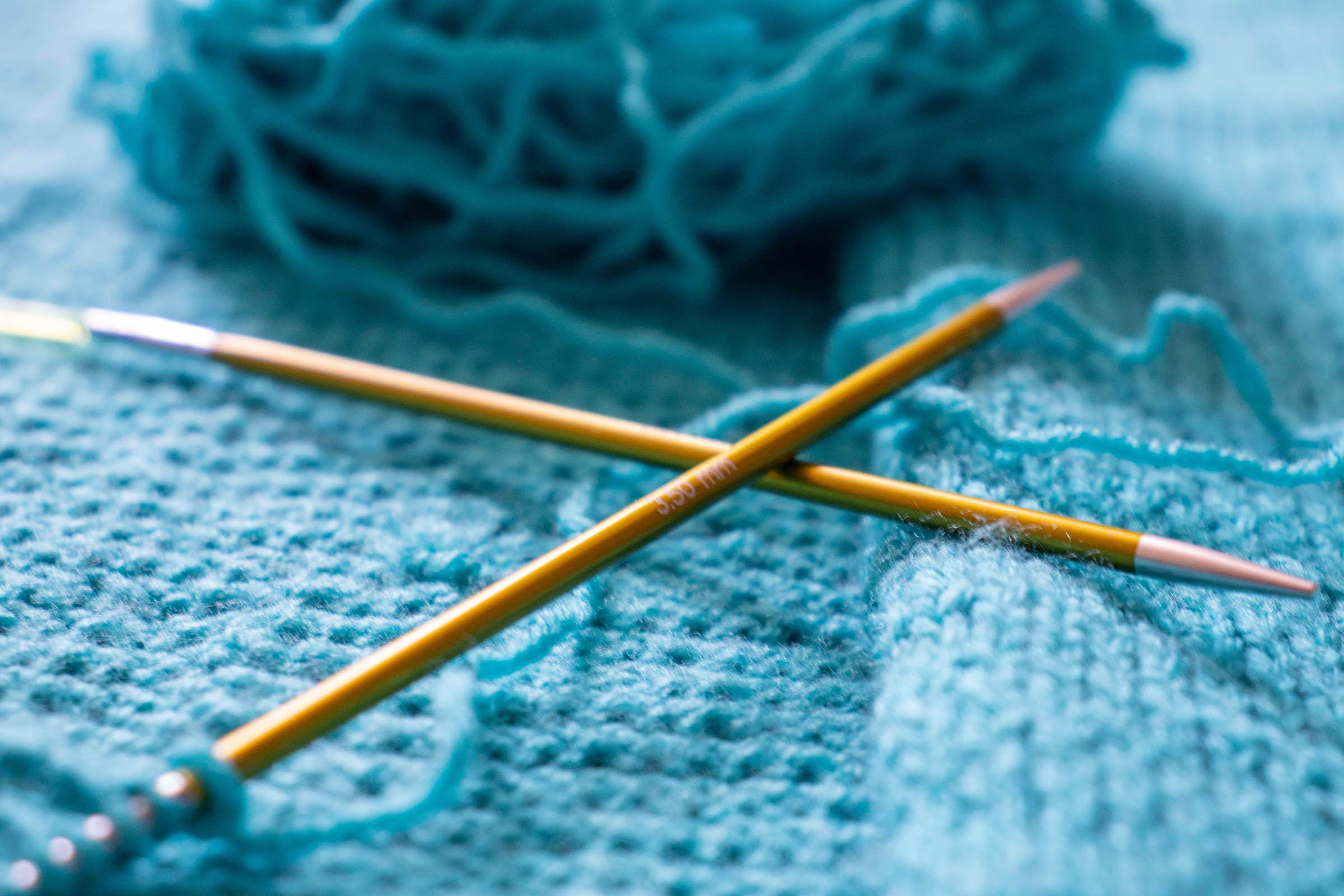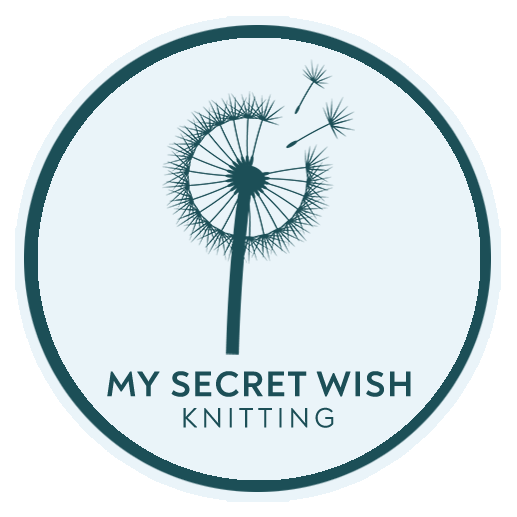
How to Knit
Lesson Nine: How to Make a Gauge Swatch
Making a Gauge Swatch
Here we are, at last—the lesson where you finally get to start applying what you’ve learned. That’s right, we’re not just going to talk about making a swatch. We’re actually going to do it.
While making a gauge swatch is an often-skipped step by new knitters, it is one of the most important things you can do to ensure your finished projects end up the size and shape they were intended to be by the designer for proper fit.
A gauge swatch is simply a square of knitting that measures about five to six inches (12.5 to 15 centimetres) square which allows you to check and see if your stitch and row count matches that required by the pattern.
Swatches can be made in plain stockinette stitch, such as the one in front, or in the pattern stitch, such as the one in back. (The one in back is a design swatch for a garment with multiple stitch patterns. While I needed these as a designer, most gauge swatches done in pattern will only ask you to do one in the most common pattern in the design.)
Why do I need a gauge swatch?
Not only does every person knit at a slightly different gauge, but different yarns and even needle materials in different combinations will create different gauges. Honestly, you may have a different gauge than yourself if you pick up your knitting after a long hiatus. So, in order to ensure proper fit, designers provide a gauge for the pattern in number of rows and stitches per a certain measurement in a given stitch pattern (usually stockinette).
It’s important to remember that the pattern will give the blocked measurement. Blocking is the process of reshaping the fabric using steam, moisture, or other techniques to help it achieve a more uniform finished stitch count and shape, and it often involves laundering the swatch as it will be laundered once the garment is complete. You will need to treat your swatch in the same way you intend to block and launder the finished garment, and check the stitch and row counts after. See more about blocking under “Finishing”.
I highly recommend you always make a gauge swatch unless the designer deems it unnecessary (which the pattern will clarify). However, the Building Blocks Cowl & Hood doesn’t require you to make a gauge swatch, so if you want to dive in and feel productive from the get-go, you can do so. Just be aware that your initial few inches may be untidy.
Then again, that’s all part of the process of learning.
Gauge and Tension
“If you have more stitches and rows than the pattern gauge, go up a needle size. If you have less, go down.”
I already discussed how to have good tension in Holding the Yarn. Proper tension is what will ensure your stitches come out neat and even.
Most yarn weights have a gauge on the label, which is made with the middle-of-the-road needle size for that yarn (as discussed in Choosing Yarn). You can create compact knits by using a smaller needle than usual for your chosen yarn weight, and airier knits by going up a needle size or three.
Your personal knitting tension also affects your stitch size, which is why it is so important to make a gauge swatch for projects that require it. (Imagine completing a sweater that is completely unwearable because you didn’t want to “waste the time” required to check your gauge. Unfortunately, I don’t have to imagine. Trust me, this is not a place you want to go to.)
If you have more stitches and rows than the pattern gauge, go up a needle size. If you have less, go down.
Making the Swatch
Most gauge swatches are done flat in stockinette stitch (which means knitting one direction and purling back) and are often given for a measurement of four inches (or 10 centimetres). Gauges on yarn labels are given in stockinette stitch.
Stockinette has the advantage of making it very easy to count stitches and rows, but it has the disadvantage of always wanting to curl to the purl side. In addition, the stitches nearest the edge of the swatch won’t give a true gauge. For this reason, we want to cast on extra width and work extra length to make sure the stitches we measure are firmly in the centre of the fabric. The more, the better. One designer, Deborah Newton, famously does eight-inch (20-centimetre) square swatches instead of only four! I usually shoot for about six-by-six inches (or 15 by 15 centimetres).
To counteract the curling effect of stockinette, I recommend including a narrow selvedge around the edges of your swatch. A selvedge is a firmer strip of fabric at the edges of a piece that lets you anchor the fabric. In this case, the selvedge will help the piece lay flat, which makes for easier counting.
Okay, time to bring it all together in your first knitting pattern.
Pattern for a Gauge Swatch
If you have a project pattern picked out, you can use the needles and yarn called for by the pattern to make a swatch.
If you haven’t selected a pattern, choose some smooth plied yarn (I recommend worsted or bulky weight), use the gauge recommendation on your yarn’s label to choose needles that will make a good size match for it, and cast on at least five to ten more stitches than the label says would fill four inches (or 10 centimetres), plus a few extra for selvedge stitches.
As an example of how to figure out your cast-on stitch count, if you’re working with worsted-weight yarn and the label says the yarn has a gauge of 20 stitches in four inches (or 10 centimetres), then cast on at least 25 stitches, plus six more stitches to give you enough for a three-stitch selvedge on either side. This gives you a total of 31 stitches.
Your goal is to have enough stitches to make at least five inches (12.5 centimetres) of measurable fabric surrounded by a half-inch (1.3 centimetres) of selvedge on either side, or roughly six inches (15 centimetres) total. Feel free to give yourself more stitches if you wish.
Cast on what you estimate will be enough stitches to make a six-inch (or 15-centimetre) row based on the pattern’s or yarn label’s gauge. Try Knit Cast On first.
Work three to five rows of garter stitch (knit every row). Garter stitch lays flat, so this is your bottom selvedge. (However, for your first one, feel free to keep going on garter stitch until you are very comfortable with the knit stitch. Then proceed to the next step.)
Switch to stockinette stitch (knit one way, purl the other). To create your edge selvedges, work three stitches along each edge in garter stitch. This means on your purl side, you would work the first and last stitches as knit. In a pattern this would read as:
Right Side Row: Knit across.
Wrong Side Row: Knit 3, purl to third-last stitch, knit 3. You can place stitch markers three stitches in from each edge to make this easier.
After you have worked about five inches (12.5 centimetres) of stockinette stitch, work three to five rows of garter stitch and bind off using Basic Bind Off (which we’ll get to in Lesson Eleven). For now, just work your garter stitch and hang tight while you read on.
You don’t need to actually break the yarn if you don’t want to waste the yarn used in your swatch. You can unravel the swatch after measuring and use that yarn in your project. However, you need to bind off before counting because you won’t get an accurate count while the work is still on the needles. Also, you should block your swatch before counting, which, depending on the method, may require you to break the yarn anyway. (More about blocking in Lesson Twelve.)
If you keep the swatch, you can use it for future reference if you use that yarn and needle combination again, or even stitch a bunch of swatches together to make a patchwork blanket. Instead of keeping a yarn cupboard full of swatches, though, you could also use the expedient of recording your gauge results in a spreadsheet or notebook and repurposing the swatch.
Measuring Gauge
Flatten the swatch with the knit side showing and lay a ruler along a row of stitches. Remember that each V is a stich. Count the stitches in four inches (10 centimetres). I find it helpful to use a needle tip to count with. Write that number down.
Flip the swatch over so the purl side is showing and lay the ruler vertically along a column of purl bumps. Count again, remembering that one row of stitches has two lines of purl bumps that are offset from each other like rows of bricks. Write that number down.
Be sure to count half or quarter stitches. This is especially important on yarns that are worsted weight or larger, and for larger projects like sweaters. These partial stitches can make a big difference in fit when multiplied around an entire project.
A gauge swatch in stockinette stitch still on the needle showing what a row and column look like on the knit side of the fabric.
Purl side of the same stockinette stitch swatch with a row and a column outlined.
You now have your stitch and row gauge. If you need to figure out how many stitches and rows you have per inch (2.5 centimetres), divide these numbers by four.
Remember, if you have more stitches and rows than the pattern gauge, go up a needle size. If you have less, go down. Then swatch again to check if you have a match.
If you need more help with how to count stitches and rows, see my tutorial about reading your knit and purl stitches.
If you need to know how to make a gauge swatch in the round, go here.
Note: If you’re making the Building Blocks Cowl & Hood first instead of making a swatch, you’ll need to know how to change skeins of yarn before you bind off, so we’ll tackle that lesson next.

